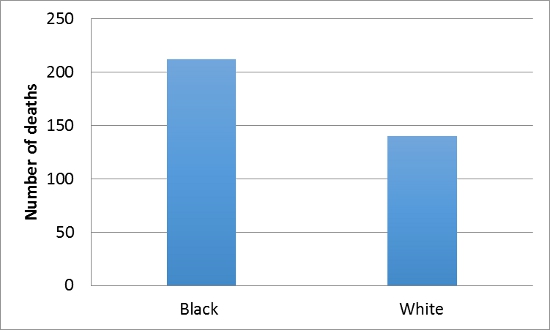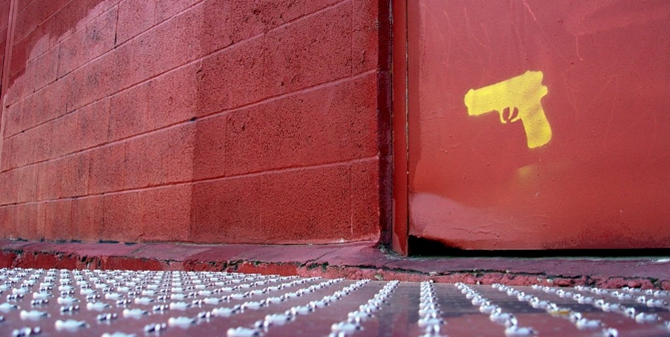 Far more Blacks than Whites are killed because of gun violence in the U.S. Despite this fact, when arguing for greater gun control, politicians tend to respond to gun violence involving whites, such as the 2012 Sandy Hook shootings. Wanda V. Parham-Payne argues that much of this difference in policy response is down to how the media portrays gun violence. She writes that the inner city gun violence that disproportionately affects Blacks is portrayed by the media as a manifestation of immorality and individual shortcomings. When gun violence involves whites, on the other hand, the assailant is often portrayed as anomalous or mentally ill.
Far more Blacks than Whites are killed because of gun violence in the U.S. Despite this fact, when arguing for greater gun control, politicians tend to respond to gun violence involving whites, such as the 2012 Sandy Hook shootings. Wanda V. Parham-Payne argues that much of this difference in policy response is down to how the media portrays gun violence. She writes that the inner city gun violence that disproportionately affects Blacks is portrayed by the media as a manifestation of immorality and individual shortcomings. When gun violence involves whites, on the other hand, the assailant is often portrayed as anomalous or mentally ill.
Nearly two years ago, a lone gunman entered into an affluent, suburban elementary school and killed 20 children and school teachers. The response from the American media was swift and intense. In addition to media pundits, government officials put out a “call to action” for stricter gun control policy. The tragedy two years ago at Newton, Connecticut, occurred against the backdrop of the continued killings of a myriad of low-income, children of color as a result of gun violence on school grounds or as part of school-related events. The American media’s response to the past and present deaths of children of color in inner city neighborhoods continues to be tepid, contributing to the general public’s perceptions, and those of the elected officials who represent them, that these deaths are a cultural manifestation of immorality and individual shortcomings.
Although there has not been a mass shooting on inner city school grounds resulting in the simultaneous deaths of multiple minors, the collective number of children or adolescents who have lost their lives due to gun violence on school grounds or in school-related events, surpasses that of children residing in predominantly White, affluent communities. In 2008, the Center for Disease Control and Prevention released statistics that illustrated children or adolescents who attended school in inner-city neighborhoods, areas historically predominated by low-income, racial and ethnic minorities, comprised a larger proportion of students who fell victim to gun violence nationwide. Such findings reflect statistics, shown in Figure 1, released by the United States Federal Bureau of Investigation in 2012 that revealed a greater number of Black adolescents between the ages of 13 and 16 are more likely to be the victims of gun violence than White adolescents in the same age group, although Blacks comprise a smaller proportion of the U.S. population.
Figure 1 – Death of Minors by Race due to gun violence in 2012

Source: FBI
Yet, despite the disproportionate number of low-income children of color who are killed by gun violence, calls to action for the creation of effective policies to stymie gun violence remain muffled, if not unheard. The manner in which local and national news media have historically framed gun violence in inner city neighborhoods versus suburban locales may, in fact, be the most substantial contributing factor to the indifferent response.
For years, the media has depicted racial and ethnic minorities in a negative manner, perpetuating stereotypes of racial and ethnic minorities as morally compromised, and hence, innately criminal. For example, in the aftermath of Hurricane Katrina, national news outlets described Blacks in search of food as “looting” while Whites were characterized as “finding” the same necessary sustenance. Subsequent opinion polls discovered that members of the general public expressed greater support for White victims versus Black victims of Hurricane Katrina who were in receipt of government assistance.
Similarly, local news media have dedicated significant portions of their programming to highlighting crimes involving racial and ethnic minorities. However, research has demonstrated that the proportion of news stories involving racial and ethnic minorities is often incongruent with the proportion of minorities actually living within the respective locales, resulting in an overrepresentation of minority groups in crime related stories.
In framing racial and ethnic minorities as the primary perpetrators of crime, local news stations have essentially compromised the public’s ability to associate minorities with the role of victim. In fact, studies have demonstrated that crimes involving a White person as the victim and a person of color, Black especially, as the assailant are more likely to garner the attention of local news stations. Conversely, research has revealed that crimes involving a Black victim are deemed ordinary, and therefore, not worthy of media attention. Indeed, crimes involving both a Black assailant and a Black victim are widely perceived as a simple cultural peculiarity and not deserving of media attention, and ultimately, the attention of the general public and their respective political representatives.
However, one could argue that when the assailant is White, such behavior is deemed mystifying and anomalous. Like other mass shootings involving a White assailant, such was the case in Newtown. Upon learning of the tragic events at Sandy Hook Elementary, many in the news media began to speculate about the mental health of the shooter, effectively implying that the shooting was a result of mental disease, and therefore, out of the control of the assailant as well outside of the norm for the area in which it occurred.
Furthermore, it should be noted that, when children within the inner city are slain, news media typically provide their name and age to simply infer innocence. Rarely is the term innocent explicitly used to characterize such children. Confounding matters, their innocence and status as victims are further obscured when members of the media speculate about the possible criminal acts of their relatives or acquaintances, suggesting their deaths are the unfortunate results of individual shortcomings and not of structural insufficiencies. On the contrary, public officials and members of the news media explicitly and repeatedly referred to the victims at Sandy Hook as innocent. Not long after, opinion polls showed policy experts, public officials, and the general citizenry advocated stricter gun control policies.
The media’s use of social rhetoric and visual imagery has long had an important impact on how the public perceives public health issues, and thus, policy responses to public health matters such as gun violence. Upon the emergence of HIV/AIDS, for instance, members of the media framed it as a lifestyle disease solely impacting homosexuals. It was only when a 13-year old White boy named Ryan White and a virgin White woman contracted the virus did the media begin to highlight the impact of the disease on those labeled as innocent victims. Subsequently, the Ryan White Act was established to provide resources to those impacted by HIV/AIDS.
In the same respect, a series of gun control policies emerged nationwide after the events in Newtown. Although federal legislation aimed at curbing gun violence was not enacted, there was a dramatic increase in the number and range of gun policies established by state governments following Sandy Hook. Thus, unlike the gun violence in inner cities that remains overlooked or framed as a consequence of a cultural abnormality, the events at Sandy Hook served as a catalyst for the creation of substantial gun control laws.
This article is based on the paper, ‘The Role of the Media in the Disparate Response to Gun Violence in America’ in the Journal of Black Studies.
Featured Image Credit: Kris (CC-BY-2.0)
Please read our comments policy before commenting.
Note: This article gives the views of the author, and not the position of USApp– American Politics and Policy, nor of the London School of Economics.
Shortened URL for this post: http://bit.ly/1p1qqB9
_________________________________
 Wanda Parham-Payne – Prince George’s Community College and American University
Wanda Parham-Payne – Prince George’s Community College and American University
Wanda Parham-Payne, Ph.D. is assistant professor of sociology at Prince George’s Community College (Largo, MD) and adjunct professorial lecturer of sociology at American University (Washington, DC). Her primary research interests include minority health disparities, the media’s social construction of innocence, and the intersection of race, class, and/or gender within the institutions of family and politics. Dr. Parham-Payne is currently writing a book entitled, The Intersection of Race and Gender within National Politics (Lexington Books) that takes a socio-historical look at the past and present roles of African-American women within the national political arena. Her blog, A Payneful Truth, can be read here.




Doubtlessly, you’re correct. I’d add that school kids have been victims ever since public schools grew from a few hundred to the thousands of students that now populate them. Blind, smothering gun control laws won’t protect them. Although they’re forced to attend at the point of a gun, public school policy steadfastly refuses to protect them with like force. Your armed friend and neighbor didn’t shoot them but probably would have volunteered to protect them.
I think that these comments have real merit. Now, I think we should also understand that when we look at “good guys” with guns that black people have a lower ownership and carry than other races. The only possible way that this imbalance can be corrected is for the good and honest people of color become involved in protecting their homes and their children. They need to start being trained and armed. The only person that is responsible for our safety is yourself. Police or government has no duty or responsibility to protect you as an individual. Violence is something that is done and over in a matter of seconds, the first responder is always the victim. Another action that black people need to take is change their voting habits, stop voting for people that want government to control everything, in this case government is not the solution but the part of the problem.
The point of the article is valid. In a year in Britain, of 553 murder victims only 39 died from gunshot wounds. Here two of every three do—not 39 a year, 23 a day. No racism has any power to explain the difference in those ratios—39 of 553 versus two of every three. The difference is effective national regulation. Britain has it. America doesn’t. Here a gun organization exercises control over public safety and the country is the murder capital of the developed world. More murder victims die from gunshot wounds in the capital of the United States than in Britain, an entire country with a population one hundred times larger.